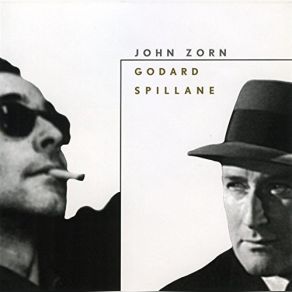Godard/spillane
Download links and information about Godard/spillane by John Zorn. This album was released in 1999 and it belongs to Jazz, Avant Garde Jazz, Free Jazz, Rock, Avant Garde Metal, Classical genres. It contains 3 tracks with total duration of 50:01 minutes.

|
|
|---|---|
| Artist: | John Zorn |
| Release date: | 1999 |
| Genre: | Jazz, Avant Garde Jazz, Free Jazz, Rock, Avant Garde Metal, Classical |
| Tracks: | 3 |
| Duration: | 50:01 |
| Buy it NOW at: | |
| Buy on Amazon $9.49 | |
| Buy on iTunes $9.99 | |
Tracks
[Edit]| No. | Title | Length |
|---|---|---|
| 1. | Godard | 18:46 |
| 2. | Spillane | 25:22 |
| 3. | Blues Nöel | 5:53 |
Details
[Edit]"Godard" and "Spillane" were the two first (and purest) examples of the "file card" composition technique developed by John Zorn and inspired by theater director Richard Foreman. The compositions were constructed from independent scraps of music inscribed on file cards; the two principal works here called for assembly of the cards ("Spillane" used 60 cards within roughly 25 minutes) to create compositions within the conceptual frame of work by Mickey Spillane and Jean-Luc Godard. The goal was to translate imagery from Godard's films and Spillane's crime novels (and probably the films based on those novels) into unified compositions. Bits of text weave through musical fragments including gentle lounge piano, spacy electronic music, violent sonic crashes, and dive-bar jazz. Ironically, "Godard" and "Spillane" both work as unified compositions because they are made of fragments. The ideas of the filmmaker and the writer would have been too complex to be tackled by an overblown, operatic score; such a work could only scratch the surface of a few of their ideas without seeming disjointed. But Zorn's file card snippets bounce around like thoughts, overlapping and intruding on each other, reversing direction like a changed mind. Careful selection and arrangement make all the snippets seem essential and irreplaceable, despite their remarkable diversity. This album's execution is aided by a truly impressive cast of supporting musicians, whose close relationships with Zorn made it possible for the musical nuances to be communicated through interpersonal interaction. As a result, every piece sounds like a pure fragment of its genre instead of mere imitation. Perhaps most impressive were the contributions of Anthony Coleman and Bill Frisell, both of whom wrenched an amazing variety of sounds from their instruments. This collection, issued by Tzadik in 1999, also contains a delightful Christmas song, "Blues Noël," which applies the file card method in a much shorter, but charming, piece.